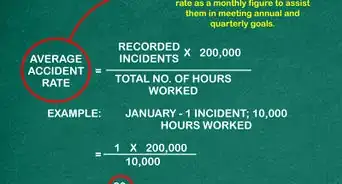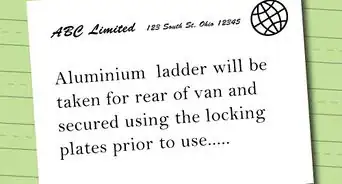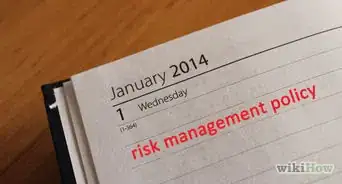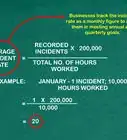This article was co-authored by Jill Newman, CPA. Jill Newman is a Certified Public Accountant (CPA) in Ohio with over 20 years of accounting experience. She has experience working as an accountant in public accounting firms, nonprofits, and educational institutions, and has also honed her communication skills via an MA in English, writing jobs, and as a teacher. She received her CPA from the Accountancy Board of Ohio in 1994 and has a BS in Business Administration/Accounting.
wikiHow marks an article as reader-approved once it receives enough positive feedback. In this case, 95% of readers who voted found the article helpful, earning it our reader-approved status.
This article has been viewed 100,248 times.
Developing and implementing a strategic asset management plan (SAMP) will allow for a detailed understanding of what physical assets are currently held, their value, future value, and costs associated with maintaining them or disposing of them. These plans are often created as part of a more comprehensive disaster plan, which can include intangible assets such as reputation, brand, and patents. We'll help you through the planning phase so you can manage your company's assets and meet your organizational objectives.
Steps
Preparing Strategic Asset Management Plans
-
1Learn how a strategic asset management plan can help. Asset management is a strategic approach to how a company conducts business, reaches decisions, and processes, uses, and communicates information. Creating a strategic asset management plan will help your organization provide services as effectively as it can. By examining which assets your organization possesses, how important they are, and what their future costs and values may be, your organization can get the highest amount of worth from its assets.[1]
- A strategic asset management plan will allow you to understand how effective your assets are being utilized.
- The value over the entire lifecycle of an asset can be determined and planned for.
- You can dispose of costly assets that are not deemed necessary and generate funding from their sale.
-
2Collect information about assets. Before you can proceed in making a strategic asset management plan you will need to collect information about the assets that you will be planning for. The focus of this inquiry is to learn how well certain assets are serving the needs of your organization. This will later allow you to learn which assets need your attention and which need to be removed.[2]
- Collect information about which assets your organization currently holds. This information should be available from company accounting records. Confirm the records with a physical audit of the tangible assets.
- Think of how well your assets are serving the goals of your organization or individual department. Consider your company's short-term and long-term goals and then use this information to help you determine how the assets may be assisting or hindering your organization.
- Take into account projected costs for any asset to learn what steps you need to take now.
Advertisement -
3Decide which assets will receive your focus. After you have taken an evaluation as to how important and how effective certain assets are to your organization you will need to prioritize the assets.[3] Work to create a list of categories for use based upon their importance and frequency of use. For example, an asset that is critical but used infrequently may be replaced by short-term rental.
- Some assets may be necessary to hold but may require upgrades.
- Certain assets may be deemed non-essential or extraneous and may not require further holding by your organization.
- For example, your organization may own a manufacturing plant or lease a building for operations or administration. The value to cost ratio of this plant will need to be assessed to fully determine just how important it is to your organization's goals. Be sure to separate individual assets within a building based upon cost, contribution, frequency of use, and importance. You will likely need to work closely with other departments to fully understand their procedures.
-
4Create strategies for each asset. Once you have a good understanding of which assets you need to focus on and in what order of importance you can begin to build your strategic asset management plan. Creating a plan for the assets will allow you to best utilize their value and avoid any risks they might come to pose to your organization over time. A basic strategic asset management plan will include the following six phases:
- Acquisitions (including leases or rentals).
- Operations.
- Maintenance.
- Disposal.
- Funding.
- Risk assessment and management.
Creating a Strategy For Assets
-
1Study necessary acquisitions. The acquisitions phase will determine which assets need to be purchased or otherwise made available. This part of the strategy will also include financial planning which details how much funding is made available for the acquisitions and where the funding will come from.[4]
- This phase may also include replacement assets.
- Cost to benefit analysis should be calculated before acquiring or leasing an asset.
- Only assets that have already been evaluated as being necessary should be acquired.
- For example, your organization might want to expand and acquiring a new facility could be part of your acquisitions planning phase.
-
2Plan for asset operations. The operational phase of the strategic asset management plan will account for existing assets and their functions in your organization. This will allow you to get a better idea of the exact role of the asset, how secure it is, who is accountable for it and how well it is performing.
- Any operational costs should be considered during this phase.
- If any training is required in relation to the asset it should be factored into this phase of the strategy.
- For example, an industrial water filter will have a certain cost attached to its function over time. Including this operational cost will let you compare it to other costs in order to make a good strategy for its management.
-
3Plan for maintenance of assets. All assets will require maintenance over time to continue serving your organization as well as they can. This phase of your strategic asset management plan will allow you to plan for the future maintenance of your assets. This phase will also detail what level of maintenance they will receive and who will be responsible for that maintenance.
- Keep in mind that all of a company's assets are important for carrying out the strategic plan. The physical assets that your organization owns will all require some type of maintenance to improve your chances of success.
- Details of planned future maintenance operations should be included in this phase.
- Include projected costs of maintenance over time.
- For example your company may own an older facility. It can be expected than that maintenance costs will likely continue to rise. These rising costs will factor into the organization's decision regarding the future of the facility.
-
4Prepare for disposal of old assets. Not all assets will be deemed important or valuable enough to continue holding. These assets requiring disposal will need to be included in your strategic asset management plan, as well as any tax consequences that may result from the disposition. You should also include the details of the disposal process including how it will be disposed of and the amount of costs incurred during the disposal process.[5]
- Include the reasons for disposal.
- List the methods of disposal.
- If the asset is being sold list the value that it could generate.
- All assets should have a disposal plan that details when they are to be disposed of and when.
- For example, your organization might have recently acquired a new shipping vessel. Even though it is new, you should have a planned retire date for the ship based on projected operational and maintenance costs compared to how critical the ship is to your company's functions.
-
5Include information regarding funding. Holding assets, maintaining them, or even disposing of old assets will require funding. During the funding phase of your strategic asset management plan you will need to detail where the funding for each asset is coming from, how much each one is receiving, what the funds are specifically being used for and whether or not they are recurring.
- Consider the cost of the asset over its entire lifetime.
- Consider costs of disposal as well as any funds generated from the sale of disposed assets.
-
6Manage risk. The risk management phase of your strategic asset management plan will detail the potential threats to your assets and their level of priority to your organization. Losses include down time, customer relations, poor press, and other factors that may damage value. A risk management plan should detail any potential risks to assets, how likely they might be, and what to do should the potential risk come to pass.
- Keep in mind that all of a company's assets, whether they are physical, financial, human, information or intangible, will have different risks associated with each of them. You will need to address all of these risks.
- Funding should be made available for the replacement of essential assets in case of an emergency.
- Plans to quickly acquire key assets in the event of their loss can be included in your risk assessment.
- For example, there may be a low risk that your company's generator will stop working as long as it is properly maintained. However, should it fail to be maintained, having a plan in place can help minimize loss.
Using the ISO 55000
-
1Understand the ISO 55000. The ISO 55000 is a standardized document that details an effective system for creating a strategic asset management plan. The ISO 55000 can help an organization to develop a plan that is a great fit for that organization's unique needs.
- The ISO 55000 will take you through the entire process of creating your strategic asset management plan.
- The ISO 55000 can help you meet regulatory laws and requirements that might be demanded from your organization.
- The ISO 55000 meets international standards including the American National Standards Institute and ASTM International standards.[6]
- The ISO 55000 is becoming a necessary standard when working with clients, insurers or investors.
-
2Discover how the ISO 55000 treats assets. The ISO 55000 is a rigorous and highly specialized text. As a result there are many specific terms that are used to make the text an effective one. Learning how the ISO 55000 defines assets can be useful when studying its content.[7]
- Assets are things of value that a company owns or is responsible for.
- Asset systems are groups of assets that must function together.
-
3Get an overview of the ISO 55000's process. The ISO 55000 specifies the overview, concepts and terminology in asset management, the ISO 55001 defines the requirements for a management system, and the ISO 55002 provides interpretation and implementation guidance for the management system.[8] The ISO 55000 offers a comprehensive plan that you can follow to build your own strategic asset management plan. The ISO 55000 achieves this goal by breaking the process down into certain stages and concepts. Understanding these concepts before you set out to utilize the ISO 55000 can help you navigate the process with less trouble. Review the following outline for a sample of what your plan might look like:
- Mission statement and introduction.
- Information about your organization including the state of your business, needs of clients, and an asset portfolio.
- A section that details the planning process that went into your strategic asset management plan.
- Objectives for your asset management program.
- Strategic plans that include targets, time-frames, priorities and who is responsible.
- Lastly your strategic asset management plan should detail risks and end with a conclusion.
-
4Get a feel for what a good strategic asset management plan looks like. The ISO 55000 offers some overall guidelines that your strategic asset management plan should have in its final form. Review some of the following key points to understand what qualities your strategic asset management plan should include:
- A planning process that is backed up by strong strategies suited to your organization.
- Your plan should include both assets and asset systems.
- Any objectives presented need to be included clearly and plainly.
Expert Q&A
-
QuestionHow can I maintain records in Microsoft Excel?
 Jill Newman, CPAJill Newman is a Certified Public Accountant (CPA) in Ohio with over 20 years of accounting experience. She has experience working as an accountant in public accounting firms, nonprofits, and educational institutions, and has also honed her communication skills via an MA in English, writing jobs, and as a teacher. She received her CPA from the Accountancy Board of Ohio in 1994 and has a BS in Business Administration/Accounting.
Jill Newman, CPAJill Newman is a Certified Public Accountant (CPA) in Ohio with over 20 years of accounting experience. She has experience working as an accountant in public accounting firms, nonprofits, and educational institutions, and has also honed her communication skills via an MA in English, writing jobs, and as a teacher. She received her CPA from the Accountancy Board of Ohio in 1994 and has a BS in Business Administration/Accounting.
Financial Advisor Maintaining a company's asset records would be easy in Excel with inventory or asset tracking templates, both available on the internet.
Maintaining a company's asset records would be easy in Excel with inventory or asset tracking templates, both available on the internet.
References
- ↑ http://nwt-funnelback01.squiz.net/s/cache?collection=nsw_treasury&doc=funnelback-web-crawl.warc&off=3008938&len=8596&url=http%3A%2F%2Fwww.treasury.nsw.gov.au%2F__data%2Fassets%2Fword_doc%2F0015%2F3309%2FHow_to_Prepare_an_Asset_Strategy.doc&profile=_default
- ↑ http://nwt-funnelback01.squiz.net/s/cache?collection=nsw_treasury&doc=funnelback-web-crawl.warc&off=3008938&len=8596&url=http%3A%2F%2Fwww.treasury.nsw.gov.au%2F__data%2Fassets%2Fword_doc%2F0015%2F3309%2FHow_to_Prepare_an_Asset_Strategy.doc&profile=_default
- ↑ http://nwt-funnelback01.squiz.net/s/cache?collection=nsw_treasury&doc=funnelback-web-crawl.warc&off=3008938&len=8596&url=http%3A%2F%2Fwww.treasury.nsw.gov.au%2F__data%2Fassets%2Fword_doc%2F0015%2F3309%2FHow_to_Prepare_an_Asset_Strategy.doc&profile=_default
- ↑ http://www.anao.gov.au/bpg_assets2010/HTML/3_1_Document_an_asset_management_startegy.html
- ↑ http://www.anao.gov.au/bpg_assets2010/HTML/3_1_Document_an_asset_management_startegy.html
- ↑ http://www.slideshare.net/FAL1/iso-55000-where-are-your-key-assets
- ↑ http://www.slideshare.net/FAL1/iso-55000-where-are-your-key-assets
- ↑ http://www.assetmanagementstandards.com/iso-55000-standards-for-asset-management/







































































